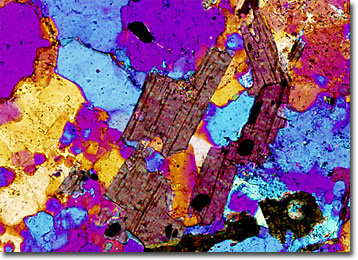Polarized Light Microscopy Digital Image Gallery
Hornblende Gneiss
Gneiss is a widespread metamorphic rock that is medium to coarse grained and often contains significant amounts of quartz and feldspar. In most other regards, gneiss is quite various and, therefore, is often named based on certain characteristics, such as parent material or mineral constituents, in order that samples of the rock may be more explicitly identified.

The distinct banding that is apparent in gneisses is usually due to a segregation of light and dark colored minerals in the rock. The light bands within the rock primarily consist of quartz and feldspar, but the composition of the darker bands may differ significantly depending on the sample. A gneiss in which the dark green or black amphibole mineral hornblende is largely responsible for the dark coloration is typically referred to as a hornblende gneiss. In such cases, hornblende is not usually the only dark mineral present, though it generally accounts for at least 20 percent of the rock’s composition. Other accessory minerals, such as biotite and pyroxene, may occur in hornblende gneisses as well, but in smaller amounts.
The term gneiss is derived from an Old Saxon word that is believed to have meant “decayed” or “worthless material.” Yet, this common rock is of a certain amount of economic importance in modern times because it is sometimes utilized as a building stone. When quarried, gneiss does not readily split along planes into thin layers like schist even though it may appear well foliated to the eye. Instead, when this rock is cleaved, it may split into any number of irregularly shaped pieces.
